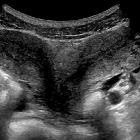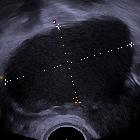Herlyn-Werner-Wunderlich-Syndrom

















Herlyn-Werner-Wunderlich (HWW) syndrome, is a rare anomaly characterized by Müllerian duct anomalies (MDA) associated with mesonephric duct anomalies . This entity is also known as obstructed hemivagina and ipsilateral renal anomaly (OHVIRA). It is not to be confused with the Wunderlich syndrome.
Clinical presentation
Presentation is typically after menarche with pelvic pain due to the obstructed hemivagina. There may be a palpable pelvic mass.
Pathology
Herlyn-Werner-Wunderlich (HWW) syndrome is characterized by a triad of type III Müllerian duct anomaly (uterus didelphys), obstructed hemivagina and mesonephric duct anomalies. Most often the latter manifests as renal agenesis but duplicated kidneys, dysplastic kidneys, rectovesical bands or crossed fused ectopia may also be seen.
Radiographic features
Irrespective of imaging modality, the typical findings are:
- duplication of the uterus, cervix and vagina
- unilateral hematocolpos or hematometrocolpos
- absent kidney on the same side as the uterovaginal obstruction
- Gartner duct cysts
Treatment and prognosis
Treatment is surgical, with resection of the septum dividing the two hemivaginas in order to relieve the obstruction. Subsequent successful pregnancy in the obstructed uterus has been reported .
Differential diagnosis
When uterovaginal obstruction results in significant dilatation, the imaging differential may include a large adnexal mass such as a cystadenoma or endometrioma.
Siehe auch:
- Uterus didelphys
- Endometriose
- einseitige Nierenagenesie
- Fehlbildungen der Gebärmutter
- Anomalien des urogenitalen Systems
- blinde (verschlossene) Hemivagina
- mesonephric duct anomalies
und weiter:

 Assoziationen und Differentialdiagnosen zu obstruierte Hemivagina und ipsilaterale renale Anomalie (OHVIRA) Syndrom:
Assoziationen und Differentialdiagnosen zu obstruierte Hemivagina und ipsilaterale renale Anomalie (OHVIRA) Syndrom:




